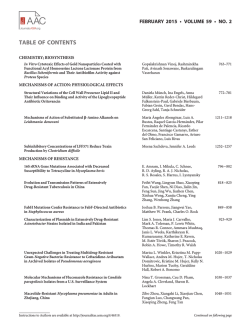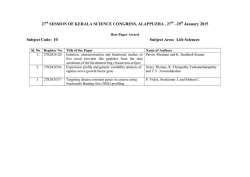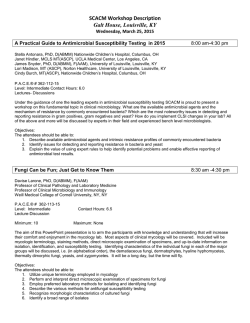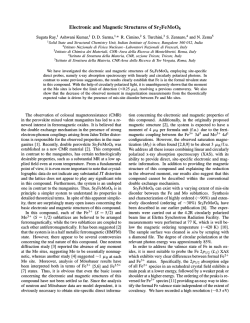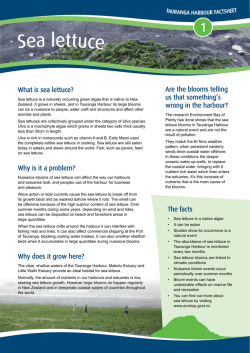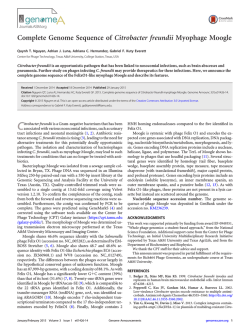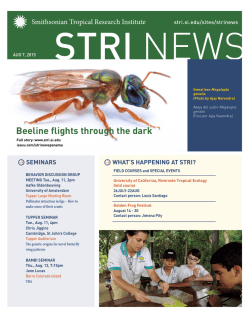
Microbiological assessment of lettuce salads and antimicrobial
PDF DE CLIENTE CHEQUEADO POR Nutr Hosp. 2015;32(5):2280-2285 ISSN 0212-1611 • CODEN NUHOEQ S.V.R. 318 Original / Otros Microbiological assessment of lettuce salads and antimicrobial resistance of Staphylococcus spp Josi Guimarães César1, Andriele Madruga Peres2, Caroline Pereira das Neves2, Érica Tupiniquim Freitas de Abreu2, Jozi Fagundes de Mello2, Ângela Nunes Moreira1,2,3 and Kelly Lameiro Rodrigues1,2 1 Programa de Posgrado en Nutrición y Alimentos, Universidad Federal de Pelotas, Facultad de Nutrición, Campus Porto, Pelotas, RS. 2Departamento de Nutrición, Universidad Federal de Pelotas, Facultad de Nutrición, Campus Porto, Pelotas, RS. 3 Programa de Posgrado en Biotecnología, Centro de Desarrollo Tecnológico, Universidad Federal de Pelotas, Campus Capão do Leão, Pelotas, RS, Brasil. Abstract Introduction: self-service restaurants in which food is served ready to be consumed are liable to have some products contaminated by pathogenic microorganisms causing food-transmitted diseases. Aim: evaluates the microbiological quality of lettuce salads in restaurants in Pelotas RS Brazil by counts of thermo-tolerant coliforms, E. coli, Staphylococcus spp. and detection of Salmonella spp. Antimicrobial resistance of Staphylococcus spp. isolates are also assessed. Methods: thirty-six samples of lettuce salads were collected from nine restaurants and thermotolerant coli forms, Escherichia coli and Staphylococcus spp. were quantified, coupled to a research on Salmonella spp., following methodology by the Bacteriological Analytical Manual. Staphylococcus spp. isolates underwent antimicrobial resistance test by the disc-diffusion method. Results and discussion: results showed that 61.1% of the salad samples contained more thermotolerant coliforms than allowed by Brazilian legislation and E. coli was confirmed in 5.6% of the samples. Positive and negative coagulase Staphylococcus occurred respectively in 5.6% and 77.8% of isolates, but no sample had Salmonella spp. Further, 56.7% of the thirty isolates of Staphylococcus spp. tested were resistant to penicillin; 46.7% to oxacillin; 26.7% to erythromycin and 23.3% were multi-resistant. Conclusion: inadequate quality of the salad was due to pathogenic microorganisms, while Staphylococcus spp. isolates had a high percentage of antimicrobial resistance. (Nutr Hosp. 2015;32:2280-2285) DOI:10.3305/nh.2015.32.5.9632 Key words: Microorganism markers. Restaurants. Antibiotics. Correspondence: Josi Guimarães César. Universidad Federal de Pelotas. Calle Pinto Martins, 652 A apto. 31. Barrio Centro. Pelotas, RS, Brasil. CEP 96020-350. E-mail: [email protected] Recibido: 10-VII-2015. Aceptado: 14-VIII-2015. EVALUCIÓN MICROBIOLÓGICA DE ENSALADAS DE LECHUGA Y PERFIL DE RESISTENCIA ANTIMICROBIANA DE STAPHYLOCOCCUS SPP Resumen Introducción: la procura por estabelecimientos que ofrecen alimentos prontos para consumo ha aumentado, sin embrago, los alimentos disponibles en estos locales pueden estar contaminados con microorganismos patogénicos, pudiendo causar enfermedades transmitidas por alimentos. Objetivos: evaluar la calidad microbiológica de las ensaladas de lechuga en los restaurantes de Pelotas RS Brasil, a través de los recuentos de coliformes termotolerantes, Escherichia coli, Staphylococcus spp. y la detección de Salmonella spp. Resistencia a los antimicrobianos de Staphylococcus spp. también se evalúan. Métodos: fueron colectadas 36 muestras de ensaladas de lechuga en nueve restaurantes y realizada la cuantificación de coliformes termotolerantes, Escherichia coli y Staphylococcus spp. e investigación de Salmonella spp., siguiendo la metodología del Bacteriological Analytical Manual. Los aislados de Staphylococcus spp. fueron sometidos al examen de resistencia a antimicrobianos por el método de difusión con discos. Resultados y discusión: de las 36 muestras de ensalada de lechuga, 61,1% presentaron cuantificación de coliformes termotolerantes superiores a lo permitido por la legislación brasileña, y hubo confirmación de E. coli en 5,6% de las muestras. La cuantificación de Staphylococcus coagulasa positiva representó 5,6% de los aislados y Staphylococcus coagulasa negativa representó 77,8%. Todas las muestras presentaron ausencia de Salmonella spp. De los 30 aislados de Staphylococcus spp. examinados, 56,7% fueron resistentes a penicilina, 46,7% a oxacilina, 26,7% a eritromicina y 23,3% fueron multirresistentes. Conclusión: la calidad microbiológica de las ensaladas de lechuga se mostró inadecuada debido a la presencia de microorganismos patogénicos, y los aislados de Staphylococcus spp. presentaron elevado porcentaje de resistencia antimicrobiana. (Nutr Hosp. 2015;32:2280-2285) DOI:10.3305/nh.2015.32.5.9632 Palabras clave: Microorganismos indicadores. Restaurantes. Antibióticos. 2280 052_9632 Microbiological assessment.indd 2280 18/10/15 6:02 PDF DE CLIENTE CHEQUEADO POR Abbreviations number and place of the restaurants was retrieved from the sanitary and food vigilance sector of the Municipal Health Office for the experimental design. Sampled population comprised 10% of the number (91) of self-service restaurants in the town, with the random selection of 9 restaurants. FD: foodborne disease. MPN: Most Probable Number. CFU: Colony-Forming Units. PCS: positive coagulase Staphylococcus. NCS: negative coagulase Staphylococcus. Collection of samples Introduction Self-service restaurants in which food is served ready to be consumed are liable to have some products contaminated by pathogenic microorganisms causing foodborne diseases (FD)1,2,3. Thermotolerant coliforms and Escherichia coli are microorganism indicators of fecal contamination; Staphylococcus spp. indicates poor hygiene conditions during food processing; and Salmonella spp. is a pathogenic microorganism which may cause infections by food4. Epidemiological data in Brazil show that Salmonella spp., positive coagulase Staphylococcus and Escherichia coli are the main agents in FD outbreaks5. Lettuce (Lactuca sativa) is consumed worldwide and has an important role on the Brazilian market. In fact, this leafy vegetable has beneficent qualities for health due to its fiber rates and antioxidant properties2,6,7,8. Since the lettuce is consumed raw, adequate hygiene process should be undertaken to eliminate pathogen microorganisms9,10,11. In fact, the lettuce has been associated with contamination by certain pathogenic microorganisms such as Salmonella spp., Escherichia coli and Listeria monocytogenes12,13. Staphylococcus spp., especially positive coagulase Staphylococcus, may occur in food intoxication outbreaks5,10,11. Further, since it acquires antimicrobial resistance and bacterial multiresistance, it becomes the main problem in the treatment of infections14. Antimicrobial resistance is actually a growing health issue in animal breeding and public health. Several bacteria in the environment are resistant and may contaminate water and food with serious consequence to health15,16. Due to their capacity in acquiring antimicrobial resistance, Staphylococcus infections are on the increase, with a greater number of multi-resistant strains and rising difficulties in their treatment17,18,19,20. Current analysis evaluates the microbiological quality of lettuce salads in restaurants in Pelotas, RS, Brazil by counts of thermo-tolerant coliforms, E. coli, Staphylococcus spp. and detection of Salmonella spp. Antimicrobial resistance of Staphylococcus spp. isolates are also assessed. Methods Experimental design and sampling A transversal analysis was conducted in self-service restaurants in Pelotas, RS, Brazil. Information on the Microbiological assessment of lettuce salads and antimicrobial resistance of Staphylococcus spp. 052_9632 Microbiological assessment.indd 2281 A sample of lettuce salad was retrieved from each restaurant (n=9), once a week, during four weeks, with a total of 36 samples. Samples were retrieved as if one were buying lettuces; collection occurred at the distribution section and the lettuces were packed in disposable thermal packages available at the restaurant. The package was closed, identified and taken immediately to the laboratory for analysis. Microbiological analyses Thermo-tolerant coliforms, Escherichia coli and Staphylococcus spp were counted and search for Salmonella spp. was undertaken, following requirements by Brazilian legislation21. Microbiological analyses followed methodology by the Bacteriological Analytical Manual22. Counts of thermo-tolerant coliforms followed the Most Probable Number (MPN) method in a Lauril Sodium Sulfate broth test (LST, Merck®) and a confirmation test in Escherichia coli broth (EC, Merck®). Confirmation analysis for E. coli was undertaken where the confirmed culture was streaked by Eosin-Methylene Blue Agar Plate Protocol (L-BEM, Merck®), incubated at 36 °C for 24 h. Typical colonies were transferred to Count Standard Agar plates (PCA, Merck®) and incubated at 36 °C for 24 h. Colonies were Gram stained and pure cultures underwent biochemical tests. For the analysis for Salmonella spp., pre-heating was done in Buffered Peptone Water (Merck®), at 37 ºC for 24 h. After incubation, 1 mL was transferred to Tetrathionate Broth (Merck®) to which 0.1mL of brilliant green and 0.2 mL iodine were added; 0.1 mL was transferred to Rappaport-Vassiliadis broth (Merck®) and incubated at 42 ºC for 24 h. Seeding in Hektoen Agar (HE, Merck®) and agar Xylose-lysine-deoxycholate (XLD, Merck®) was performed after the above selective enrichment; it was then incubated at 37 ºC for 24 h. Characteristic colonies underwent biochemical and serum tests. Three decimal dilutions were performed for the isolation of Staphylococcus spp. and 1 mL of each was divided into three Agar Baird Parker plates (BP, Merck®) enriched with egg yolk emulsion and potassium tellurite 1% by surface spreading, and incubated at 37 ºC for 48 h. Further, typical and atypical presumptive colonies were counted and given in Colony-Forming Units per gram of food (CFU/g). Isolated colonies were Gram-stained and the characteristic and pure ones were Nutr Hosp. 2015;32(5):2280-2285 2281 18/10/15 6:02 PDF DE CLIENTE CHEQUEADO POR selected. A loopful of each selected colony was inoculated in Brain Heart Infusion broth (BHI, Merck®) and incubated at 37 ºC for 24 h. The coagulase test was performed and colonies with coagulates were considered positive; otherwise they were considered negative. Antimicrobial resistance Antimicrobial resistance by disc diffusion technique was verified from isolates of positive coagulase Staphylococcus (PCS) and negative coagulase Staphylococcus (NCS), according to the Clinical and Laboratory Standards Institute (CLSI)23. Isolates were first cultivated in BHI broth (Merck®) at 36 ºC and inoculated in a saline solution 0.85 % (Merck®) till Mac Farland scale 0.5. The culture was then spread on a plate containing Agar Muller Hinton (MH, Merck®) and the antimicrobial discs (Invitrogen®); they were similar spread and incubated at 37 ºC for 24 h for Gram positive bacteria. Halo was measured in centimeters from one extremity to the other and result was obtained by comparing tables for CLSI resistance standard23. The 12 antimicrobial agents tested composed the antimicrobial disc: ampicillin (10 µg), penicillin (10 units), oxacillin (1 µg), clindamycin (2 µg), sulfamethoxazole/trimethoprim (23.75/1.25 µg), chloramphenicol (30 µg), erythromycin (15 µg), gentamicin (10 µg), tetracycline (30 µg), vancomycin (30 µg), ciprofloxacin (5 µg), cefepime (30 µg), rifampicin (5 µg) (CLSI, 2007). Statistical analysis Statistical analyses were performed with SPSS® (Chicago, v. 17.0, 2008) for antimicrobial resistance test. Results and discussion Twenty-two (61.1%) of the 36 lettuce salad samples analyzed contained thermotolerant coliforms above the limit allowed by Brazilian legislation, or rather, up to 102 NMP/g21 (Table I). Table I Amount of thermotolerant coliforms in samples of lettuce salads. Pelotas, 2015. (n=36) Samples n (%) Thermotolerant coliforms Counts (MPN/g) 15 (41.7) 1.1x103 a > 1.1x103 7 (19.4) 1.6x102 to 4.6x102 10 (27.8) 3.6 to 93 4 (11.1) <3 MPN/g – Most Probable Number per gram of food. 2282 052_9632 Microbiological assessment.indd 2282 Nutr Hosp. 2015;32(5):2280-2285 Brandão et al.24 evaluated 30 samples of lettuce salad in self-service restaurants in Rio de Janeiro, RJ, Brazil and detected 22 samples (73.3%) contaminated by thermotolerant coliforms, with 6 samples (19.9%) above the limit allowed by Brazilian legislation. Another study evaluated the microbiological quality of lettuce salads in 10 self-service restaurants in Gurupi, TO, Brazil and reported 12 samples (60%) contaminated by thermotolerant coliforms above the minimum rate25. Moreover, two samples (5.6%) out of the 36 samples in current analysis were confirmed for E. coli, with 3.6 MPN/g in each sample. Several other studies register E. coli in lettuces ready for consumption, with percentages ranging between 3.5 and 30% contamination24,26,27,28. The amount of thermotolerant coliforms at percentages higher than those permitted by the legislation in ready foods, and the confirmation of E. coli indicate either improper prime matter conditions, or unsatisfactory food processing conditions or inadequate hygiene-sanitary conditions21,24,29,30,31. Contamination in current analysis may be related to the fact that lettuce salads were served raw and either there were inadequate hygiene procedures during food handling or contamination occurred in the post-processing period4,24,27,28. No Salmonella spp. was reported in any of the analyzed samples (25 g of food) and thus Brazilian legislation was complied with (BRASIL, 2001). Results were similar to other studies that assessed Salmonella spp. in lettuce salad24,26,27,28,32. Two (5.6%) out of the 36 samples were reported with PCS, whereas 28 (77.8%) were reported with NCS (Table II). Whereas a study in São Bernardo do Campo, SP, Brazil evaluated 30 samples of raw green vegetables in self-service restaurants and detected one sample (3.3%) with PCS33. Another study in Porto Alegre, RS, Table II Quantity of Staphylococcus spp. in lettuce salad samples. Pelotas, 2015. (n=36) Samples Positive coagulase Staphylococcus Negative coagulase Staphylococcus n (%) Counts (CFU/g) 1 (2.8) 2x105 1 (2.8) 2x103 (est.) 34 (94.4) < 10 13 (36.1) 1x105 a 5x105 9 (25.0) 1x104 a 7.0x104 5 (13.9) 3x103 a 9x103 1 (2.8) 9x102 8 (22.2) < 10 CFU/g – Colony-Forming Unit per gram of food; (est.) - estimated count Josi Guimarães César et al. 18/10/15 6:02 PDF DE CLIENTE CHEQUEADO POR multi-resistant, of which one isolate was resistant to six antimicrobial agents (clindamycin, vancomycin, erythromycin, rifampicin, oxacillin and penicillin). Similar studies on antimicrobial resistance of Staphylococcus isolates also reported multi-resistance to the same anti-microbial agents44,47,48. Several mechanisms may trigger bacterial multi-resistance: either by intercellular decrease of the antimicrobial agent by an alteration in the permeability of the external membrane and decrease transport through the internal membrane, or by active efflux through enzyme mutation or modification and the deviation of the drug to the target49. Multi-resistant isolates may increase the number of highly persistent infections, limit the use of available antimicrobial agents and, consequently, make difficult clinical treatment, increase the dissemination of infections, hospital costs and mortality rates14,50. Brazil evaluated 26 samples of different types of food, including raw and boiled salads, and reported 15 samples (57.7%) contaminated with NCS. The same study assessed the hands of 21 food handlers and discovered 9 people with Staphylococcus spp.34. Although staphylococcus contamination occurs by inadequate hygiene of hands, the production of toxins occurs in food with Staphylococcus spp. counts over 105 CFU/g5,18,30,31,35,36,37. Moreover, Staphylococcus spp. is resistant to several antimicrobial classes and may cause illness and even death owing to infections38,39,40,41. The microbial resistance test (n=30) was undertaken from Staphylococcus spp. isolates. Results revealed that isolates had a higher resistance percentage to penicillin (56.7%), oxacillin (46.7%) and erythromycin (26.7%). Only one isolate (3.3%) had an intermediate resistance to the antimicrobial agent erythromycin. All Staphylococcus spp. isolates under analysis were sensitive to the antimicrobial agent gentamycin (Table III). Other studies that evaluated the antimicrobial resistance of S. aureus, a PCS isolated from food and humans, detected 31 (58.5%) of samples resistant to penicillin40; 133 (47.6%) resistant to oxacillin42; 29 (22.7%) resistant to erythromycin43 and 8 (100%) samples sensitive to gentamicin44. Penicillin and oxacillin belong to the antimicrobial β-lactam class and antimicrobial resistance occurs through the interference in the synthesis and remodeling of bacterial peptidoglycans. However, erythromycin belongs to the macrolide class and its antimicrobial resistance occurs by the inhibition of protein synthesis of the susceptible bacterial cells in the 50S ribosomal subunit. β-lactam resistance in positive Gram bacteria mainly occurs on the alteration of the target protein, with enzyme degradation39,45,46. Seven (23.3%) among the 30 Staphylococcus spp. isolates evaluated for antimicrobial resistance were Conclusion The microbiological quality of lettuce salads is very poor. Although Salmonella spp. was not detected, more than half the samples contained thermotolerant coliforms above the limit permitted by legislation. Important pathogens in food, such as E. coli and Staphylococcus spp. were reported, coupled to a high percentage of antimicrobial resistance of isolated microorganisms. Acknowledgement The researchers would like to thank the Coordination of Superior Level Staff Improvement (Coordenação de Aperfeiçoamento de Pessoal de Nível Superior – CAPES). Table III Antimicrobial resistance test of Staphylococcus spp. isolates in lettuce salad. Pelotas, 2015. (n=30) Antimicrobial agents Sensitive (%) Intermediate (%) Resistant (%) Vancomycin 96.7 0 3.3 Erythromycin 70 3.3 26.7 Chloramphenicol 93.3 0 6.7 Rifampicin 96.7 0 3.3 Cefepime 93.3 0 6.7 Oxacillin 53.3 0 46.7 Penicillin 43.3 0 56.7 Ciprofloxacin 90 0 10 Gentamicin 100 0 0 Tetracycline 96.7 0 3.3 Sulfamethoxazole/trimethoprim 96.7 0 3.3 Microbiological assessment of lettuce salads and antimicrobial resistance of Staphylococcus spp. 052_9632 Microbiological assessment.indd 2283 Nutr Hosp. 2015;32(5):2280-2285 2283 18/10/15 6:02 PDF DE CLIENTE CHEQUEADO POR References 1. Welker CAD, Both JMC, Longaray SM, Haas S, Soeiro MLT, Ramos RC. Análise microbiológica dos alimentos envolvidos em surtos de doenças transmitidas por alimentos (DTA) ocorridos no estado do Rio Grande do Sul, Brasil. Rev Bras Bioc 2010; 8: 44-48. 2. Pereira EL, Rodrigues A, Ramalhosa E. Influence of working conditions and practices on fresh-cut lettuce salads quality. Food Control 2013; 33: 406–412. doi: 10.1016/j.foodcont.2013.03.021. 3. Leong D, Alvarez-Ordóñez A, Jordan K. Monitoring occurrence and persistence of Listeria monocytogenes in foods and food processing environments in the Republic of Ireland. Front. Microbiol 2014; 5: 4361-4368. doi: 10.3389/fmicb.2014.00436. 4. Franco BDGM, Landgraf M. Microbiologia dos alimentos. Vol. I. Artmed, Porto Alegre; 2008. 5. Brasil. 2014. Ministério da Saúde. Secretaria de Vigilância e Saúde. Vigilância Epidemiológica das Doenças de Transmissão de Alimentos Hídrica e Alimentar (VE-DTA). Dados epidemiológicos de 200 a 2014. [Internet]. 2001 [acesso 2015 abr 12]. Disponível em: <http:// www.saude.gov.br/ 6. Abreu IMO, Junqueira AMR, Peixoto JR, Oliveira AS. Qualidade microbiológica e produtividade de alface sob adubação química e orgânica. Ciênc Tecnol Aliment 2010; 30: 108-118. doi: 10.1590/S0101-20612010000500018. 7. Zhou T, Harrison AD, Mckellar R, Young JC, Odumeru J, Piyasena P. Determination of acceptability and shelf life of ready-to-use lettuce by digital image analysis. Food Res Int 2004; 37: 875-881. doi: 10.1016/j.foodres.2004.05.005. 8. Mogharbel ADI, Masson ML. Perigos associados ao consumo da alface, (Lactuca sativa), in natura. Alim Nutr Araraquara 2005; 16: 83-88. 9. Moreira IS, Souza FC, Santos FM, Feitosa MKSB, Marques LF. Eficiência de soluções antimicrobiana na desinfecção de alface tipo crespa comercializada em feira livre. Rev Verde 2013; 8: 171-177. doi: 10.18378/rvads.v8i2.2196. 10. Bennett SD, Walsh KA, Gould LH. Foodborne disease outbreaks caused by Bacillus cereus, Clostridium perfringens, and Staphylococcus aureus - United States, 1998-2008. Clin Infect Dis 2013; 57: 425-433. doi: 10.1093/cid/cit244. 11. Ho J, Boost M, O’Donoghue M. Sustainable reduction of nasal colonization and hand contamination with Staphylococcus aureus in foodhandlers, 2002-2011. Epidemiol Infect 2014; 13: 1-10. doi: 10.1017/S0950268814002362. 12. Jablasone J, Warriner K, Griffiths M. Interactions of Escherichia coli O157:H7, Salmonella typhimurium and Listeria monocytogenes plants cultivated in a gnotobiotic system. Int J Food Microbiol 2005; 99: 7-18. 13. Jeddi MZ, Yunesian M, Gorji ME, Noori N, Pourmand MR, Khanik GRJ. Microbial Evaluation of Fresh Minimally-processed Vegetables and Bagged Sprouts from Chain Supermarkets. J Health Popul Nutr 2014; 32: 391-399. 14. Deleo FRE, Chambers HF. Reemergence of antibiotic-resistant Staphylococcus aureus in the genomics era. J Clin Invest 2009; 119: 2464-2474. doi: 10.1172/JCI38226. 15. Normanno G, La Salandra G, Dambrosio A, Quaglia NC, Corrente M, Parisi A, Santagada G, Firinu A, Crisetti E, Celano GV. Occurrence, characterization and antimicrobial resistance of enterotoxigenic Staphylococcus aureus isolated from meat and dairy products. Int J Food Microbiol 2007; 115: 290-296. 16. Resch M, Nagel V, Hertel C. Antibiotic resistance of coagulase-negative staphylococci associated with food and used in starter cultures. Int J Food Microbiol 2008; 127: 99-104. doi: 10.1016/j.ijfoodmicro.2008.06.013. 17. Gorwitz RJ, Kruszon-Moran D, Mcallister SK, MCquillan G, Mcdougal LK, Fosheim GE, Jensen BJ, Killgore G, Tenover FC, Kuehnert MJ. Changes in the prevalence of nasal colonization with Staphylococcus aureus in the United States, 20012004. J Infect Dis 2008; 197: 1226-1234. doi: 10.1086/533494. 18. Chambers HF, Deleo FR. Waves of resistance: Staphylococcus aureus in the antibiotic era. Nat Rev Microbiol 2009; 7: 629641. doi: 10.1038/nrmicro2200. 2284 052_9632 Microbiological assessment.indd 2284 Nutr Hosp. 2015;32(5):2280-2285 19. Montoya IC, Mira MO, Álvarez IA, Cofre JG, Cohen JV, Donoso GW, Torres JPT. Resistencia inducible a clindamicina em Staphylococcus aureus meticilino resistente. Rev Chil Pediatr 2009; 80: 48-53. doi: 10.4067/S0370-41062009000100006. 20. Rinsky JL, Nadimpalli M, Wing S, Hall D, Baron D, Price LB, Larsen J, Stegger M, Stewart J, Heaney CD. Livestock-Associated Methicillin and Multidrug Resistant Staphylococcus aureus Is Present among Industrial, Not Antibiotic-Free Livestock Operation Workers in North Carolina. PLoS One 2013; 8: e67641. DOI: 10.1371/journal.pone.0067641. 21. Brasil. Ministério da Saúde. Agência Nacional de Vigilância Sanitária. Regulamento Técnico sobre padrões microbiológicos para alimentos. Resolução Resolução nº. 12 de 02 de janeiro de 2001. [Internet]. 2001 [acesso 2015 abr 12]. Disponível em: <http://www.anvisa.gov.br/ 22. Food and Drug Administration (FDA). Bacteriological Analytical Manual. AOAC International, Gaithersburg; 2001. 23. Clinical and Laboratory Standards Institute (CLSI). Performance standard for antimicrobial susceptibility testing. EUA; 2007. 24. Brandão MLL, Almeida DO, Bispo FCP, Bricio SML, Marin VA, Miagostovich MP. Assessment of Microbiological Contamination of Fresh, Minimally Processed, and Ready-to-Eat Lettuces (Lactuca sativa), Rio de Janeiro State, Brazil. J Food Sci 2014; 79: 961-966. doi: 10.1111/1750-3841.12459. 25. Junior JP, Gontijo EEL, Silva MG. Perfil parasitológico e microbiológico de alfaces comercializadas em restaurantes self-service de Gurupi-TO. Rev Cient do ITPAC Araguaína. 2012; 5: Pub.2. 26. Loncarevic S, Johannessen GS, Rorvik LM. Bacteriological quality of organically grown leaf lettuce in Norway. Lett Appl Microbiol 2005; 41: 186-189. 27. Oliveira M, Usall J, Viñas I, Anguer AM, Gatius F, Badias M. Microbiological quality of fresh lettuce from lettuce from organic and conventional production. Food Microbiol 2010; 27: 679-684. doi: 10.1016/j.fm.2010.03.008. 28. Althaus D, Hofer E, Corti S, Julmi A, Stephan R. Bacteriological Survey of Ready-to-Eat Lettuce, Fresh-Cut Fruit, and Sprouts Collected from the Swiss Market. J Food Prot 2012; 75: 1338-1341. doi: 10.4315/0362-028X.JFP-12-022. 29. Silva ND, Junqueira VCA, Silveira NFA, Taniwaki MH, Santos RFS, Gomes RAR. Manual de métodos de análise microbiológica de alimentos. Vol. IV. Livraria Varela, São Paulo; 2010. 30. Silva Júnior EA.. Manual de controle higiênico-sanitário em serviços de alimentação. Vol. VI. Livraria Varela, São Paulo; 2012. 31. Oliveira ABAC, Silveira R, Trindade JT, Cardoso EC, Itapema MR. Avaliação da presença de microrganismos indicadores higiênico-sanitários em alimentos servidos em escolas públicas de Porto Alegre, Brasil. Ciên & Saúde Coleti 2013; 18: 955-962. 32. Maistro LC, Miyaa NTN, Sant’anab AS, Pereira JL. Microbiological quality and safety of minimally processed vegetables marketed in Campinas, SP – Brazil, as assessed by traditional and alternative methods. Food Control 2012; 28: 258-264. doi:10.1016/j.foodcont.2012.05.021. 33. Calil BEM, Ferreira FLA, Brazão CS, Sovenhi CC. Qualidade microbiológica de saladas ofrecidas em restaurantes tipo self-service. ASA 2013: 1, 36-42. 34. Mello JF, Rocha LB, Lopes ES, Frazzon J, COSTA MSanitary quality, occurrence and identification of Staphylococcus sp. in food services. Braz J Microbiol 2014; 45: 1031-1037. doi: 10.1590/S1517-83822014000300036. 35. Rizek CF, Matté MH, Dropa M, Mamizuka EM, DE Almeida LM, Lincopan N, Matté, GR, Germano, PM. Identification of Staphylococcus aureus carrying the mecA gene in ready-to-eat food products sold in Brazil. Foodborne Pathog Dis 2011; 8: 561-563. doi: 10.1089/fpd.2010.0706. 36. Gücükoğlu A, Çadirci Ö, Terzi G, Kevenk TO, Alişarli M. Determination of enterotoxigenic and Methicillin Resistant Staphylococcus aureus in ice cream. J Food Sci 2013; 78: 738741. doi: 10.1111/1750-3841.12093. 37. Bhunia A. Foodborne microbial phatogens – mechanisms and pathogenesis. Springer, New York; 2008. Josi Guimarães César et al. 18/10/15 6:02 45. 46. 47. 48. 49. 50. ly Used Antibiotics in Saudi Arabia. Foodborne Pathog Dis 2011; 8: 1011-1018. doi: 10.1089/fpd.2010.0805. Xu J, Shi C, Song M, Xu X, Yang P, Paoli G, Shi X. Phenotypic and Genotypic Antimicrobial Resistance Traits of Foodborne Staphylococcus aureus Isolates from Shanghai. J Food Sci 2014; 79: 635-642. DOI: 10.1111/1750-3841.12405. Weisblum B. Erythromycin Resistance by Ribosome Modification. Antimicrob Agents Chemother 1995; 39: 577-585. Hammad AM, Watanabe W, Fujii T, Shimamoto, T. Occurrence and characteristics of methicillin-resistant and-susceptible Staphylococcus aureus and methicillin-resistant coagulase-negative staphylococci from Japanese retail ready-to-eat raw fish. Int J Food Microbiol 2012; 156: 286-289. doi: 10.1016/j.ijfoodmicro.2012.03.022. Ye Y, Jiang Q, Wu Q, Zhang J, Lu J, Lin L. The Characterization and Comparison of Staphylococcus aureus by Antibiotic Susceptibility Testing, Enterobacterial Repetitive Intergenic Consensus–Polymerase Chain Reaction, and Random Amplified Polymorphic DNA–Polymerase Chain Reaction. Foodborne Pathog Dis 2012; 9: 168-171. doi: 10.1089/fpd.2011.0927. Depardieu F, Podglajen I, Leclercq R, Collatz E, Courvalin P. Modes and modulations of antibiotic resistance gene expression. Clin Microbiol Rev 2007; 20: 79-114. doi: 10.1128/ CMR.00015-06. Wang X, Li G, Xia X, Yang B, Xi M, Meng J. Antimicrobial susceptibility and molecular typing of methicillin-resistant Staphylococcus aureus in retail foods in Shaanxi, China. Foodborne Pathog Dis. 2014; 11: 28128-28136. doi: 10.1089/fpd.2013.1643. PDF DE CLIENTE CHEQUEADO POR 38. Erkan M, Vural A, Oezekinci T. Investigating the presence of Staphylococcus aureus and coagulase negative Staphylococci (CNS) in some leafy green vegetables. Res Biol Sci 2008; 3: 930-933. 39. Spanu V, Scarano C, Cossu F, Pala C, Spanu C, De Santis EP. Antibiotic Resistance Traits and Molecular Subtyping of Staphylococcus aureus Isolated from Raw Sheep Milk Cheese. J Food Sci 2014; 79: 2066-2071. doi: 10.1111/1750-3841.12590. 40. Wang X, Wang Y, Guo G, Usman T, Hao D, Tang X, Zhang Y, Yu Y. Antimicrobial resistance and toxin gene profiles of Staphylococcus aureus strains from Holstein milk. Lett Appl Microbiol 2014; 58: 527-534. doi: 10.1111/lam.12221. 41. Souza M, Silva N, Igrejas G, Silva F, Sargo R, Alegria N, Benito D, Gómez P, Lozano C, Gómez-Sanz E, Torres C, Caniça M, Poeta P. Antimicrobial resistance determinants in Staphylococcus spp. recovered from birds of prey in Portugal. Vet Microbiol 2014; 171: 436-440. doi: 10.1016/j.vetmic.2014.02.034. 42. Pournajaf A, Ardebili A, Goudarzi L, Khodabandeh M, Narimani T, Abbaszadeh H. PCR-based identification of methicillin-resistant Staphylococcus aureus strains and their antibiotic resistance profiles. Asian Pac J Trop Biomed 2014; 4: 293-297. doi: 10.12980/APJTB.4.2014C423. 43. Kumar R, Yadav BR., Singh RS. Genetic determinants of antibiotic resistance in Staphylococcus aureus isolates from milk of mastitic crossbred cattle. Curr Microbiol 2010; 60: 379-386. doi: 10.1007/s00284-009-9553-1. 44. Hassan AS, Altalhi AD, Gherbawy YA, El-Deeb BA. Bacterial Load of Fresh Vegetables and Their Resistance to the Current- Microbiological assessment of lettuce salads and antimicrobial resistance of Staphylococcus spp. 052_9632 Microbiological assessment.indd 2285 Nutr Hosp. 2015;32(5):2280-2285 2285 18/10/15 6:02
© Copyright 2025
